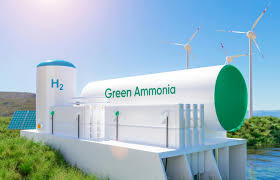Green Ammonia:

Larsen & Toubro’s (L&T), green molecules arm L&T Energy Greentech, recently bagged the tender for building India’s biggest green hydrogen plant at Indian Oil Corporation Ltd’s (IOCL) Panipat refinery.
- Ammonia (NH3) is a nitrogen and hydrogen based chemical compound widely used in the production of fertilisers and industrial chemicals.
- Ammonia is currently produced from natural gas and, in its production process, emits 2 tonnes of CO₂ for every tonne of ammonia.
- For this reason, conventional ammonia is referred to as grey ammonia.
- Green ammonia, on the other hand, does not emit CO₂ in its production process.
- To produce green ammonia, green hydrogen must first be obtained through a process of water electrolysis.
- That is, water is decomposed into hydrogen and oxygen, using electrical energy generated from renewable sources.
- The hydrogen is then combined with atmospheric nitrogen through a process known as Haber-Bosch synthesis, which allows hydrogen and nitrogen to react at high pressure and temperature in the presence of a catalyst to form ammonia.
- The end result is the production of green ammonia using green hydrogen and atmospheric nitrogen.
- Green ammonia production is where the process of making ammonia is 100% renewable and carbon-free.
- It is widely used in the production of agricultural fertilisers as ammonia is an essential source of nitrogen for plant growth.
- It is also used as a raw material in the production of a variety of chemical products, such as nitric acid, synthetic fibres, explosives, dyes, and pharmaceuticals.]
- It can be used in fuel for engines such as locomotives and shipping, replacing diesel and marine fuel oil.
- It can be used as a fuel source for electricity power generation.




